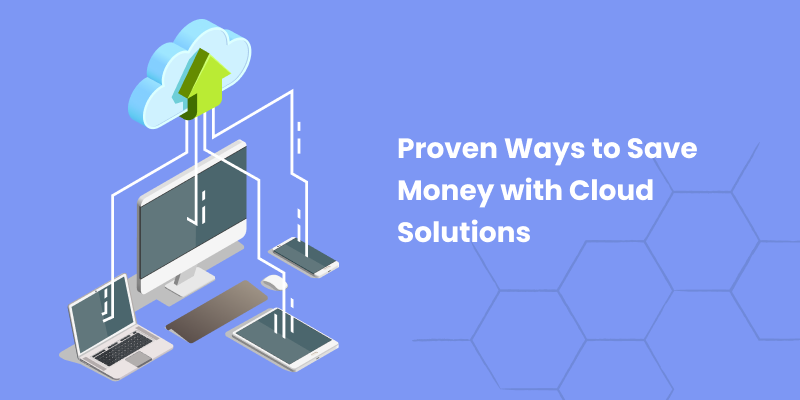Proven Ways to Save Money with Cloud Solutions

Cloud computing offers incredible benefits, including the potential to save money.
But how do you ensure you're truly cutting costs and not wasting resources?
This guide will help you understand the two main aspects of cloud savings:
Saving by Moving to the Cloud: Cloud computing can reduce expenses compared to running everything on your hardware.
Optimizing Costs Once You're in the Cloud: Using smart strategies to control and minimize ongoing cloud costs.
Why Cloud Costs Can Be High
While the cloud allows you to pay for what you use, many services charge you even if resources aren't fully utilized.
A Gartner report estimates that up to 70% of cloud spending is wasted! You can save significantly by gaining visibility into your usage and optimizing resources.
In this guide, we’ll explore:
Four Financial Benefits of Cloud Computing
Five Proven Strategies to Cut Cloud Costs
Maximizing Savings with Tools like Spot by NetApp
4 Financial Benefits of Cloud Computing
.png)
Lower Maintenance Costs
- When you move to the cloud, the provider manages much of the infrastructure, saving you time and money.
- For example, they handle server maintenance, security, and updates.
- However, you’re still responsible for managing your data and applications, so understand the shared responsibility model.
Lower Capital Costs
- With the cloud, you don’t need to buy expensive hardware for peak usage.
- Instead, you can scale up or down based on actual demand.
- This converts big upfront costs into manageable monthly expenses.
- However, over time, evaluate whether cloud costs are lower than running your infrastructure.
Cost Agility
- The cloud’s flexibility helps you adjust quickly to changing business needs.
- You can allocate resources where needed and reduce waste, improving your return on investment (ROI).
Improved Resilience
- Downtime is expensive. The cloud makes it easier to recover quickly from failures.
- You can run resources in multiple locations, set up backups, and even have disaster recovery solutions ready at the click of a button.
- This helps save money by reducing the costs associated with downtime.
Top 5 Strategies for Enterprises to Optimize Cloud Costs
.png)
Cloud computing offers significant advantages, particularly in cost reduction.
Below, we explore five proven strategies enterprises can use to optimize their cloud investments and achieve substantial savings.
Reduced Infrastructure Costs
One of the most compelling benefits of adopting cloud solutions is the ability to reduce infrastructure expenses.
Key Advantages
Lower Capital Expenditures: With the cloud’s pay-as-you-go model, businesses avoid hefty upfront costs for hardware and only pay for the resources they use.
Reduced Maintenance Costs: Cloud providers handle infrastructure maintenance, upgrades, and security, saving companies both time and money.
Scalability Without Large Investments: Businesses can scale resources up or down as needed, avoiding the need for costly infrastructure expansions.
Example
A mid-sized enterprise moved from a traditional data center to the cloud, decommissioning aging servers and reducing its data center footprint.
This transition cut energy consumption by 30% and provided the agility to adapt to changing business needs.
Improved Resource Utilization
Cloud solutions enhance resource allocation by providing a flexible and scalable environment, reducing wasted capital from underutilized infrastructure.
Key Benefits
Pay-As-You-Go Pricing: Businesses are billed only for the resources they consume, eliminating unnecessary expenses.
Efficient Use of Resources: Resources are dynamically allocated based on real-time needs, ensuring optimal performance.
Avoidance of Over-Provisioning: Automatic scaling prevents overinvestment in IT resources, handling fluctuating workloads cost-effectively.
Example
A retail company used cloud solutions to handle holiday traffic spikes.
By automatically scaling resources during peak times and scaling down during off-peak periods, the company achieved significant cost savings.
Enhanced Flexibility and Scalability
Cloud solutions offer unparalleled flexibility and scalability, allowing businesses to adapt resources almost instantly based on demand.
Key Benefits
Cost Savings During Low-Demand Periods: Businesses can scale down resources during slower periods, saving on costs.
No Over-Investment in Capacity: Enterprises can start small and scale as needed, avoiding financial risks.
Quick Adaptation to Business Needs: The agility of cloud solutions supports innovation and competitiveness.
Example
An e-commerce company scaled its server capacity up during major sales events and down during quieter periods, ensuring a seamless shopping experience while reducing costs.
Streamlined IT Operations
Cloud adoption simplifies IT operations, reducing complexity and associated costs.
Key Benefits
Lower IT Staff Costs: Cloud providers manage infrastructure, freeing in-house IT teams to focus on strategic initiatives.
Automated Maintenance and Updates: Cloud platforms automate updates and security patches, reducing downtime and enhancing security.
Simplified Management: Centralized dashboards make resource monitoring and management more straightforward.
Example
A growing business transitioned to a cloud-based environment, automating routine tasks and simplifying IT management.
This shift allowed the company to focus on innovation and maintain a competitive edge.
Increased Innovation and Productivity
The cloud fosters innovation and productivity by providing a robust, flexible, and scalable infrastructure.
Key Benefits
Faster Deployment of Applications: Rapid development and deployment reduce time-to-market for new products.
Improved Collaboration Tools: Cloud-based tools enable seamless team collaboration regardless of location.
Access to Advanced Technologies: Cloud platforms provide access to AI, ML, and big data analytics, empowering smarter decision-making.
Example
A global software development company adopted cloud solutions for its development and testing environments.
This move accelerated application deployment, integrated advanced AI features, and enhanced the company’s value proposition.
Multi-Cloud and Hybrid Cloud Strategies
Cost Benefits of Multi-Cloud Deployments
- Optimized Pricing: Using multiple cloud providers allows businesses to select the most cost-effective services for specific needs.
- Reduced Vendor Lock-In: Spreading workloads across various providers prevents dependence on a single vendor, improving flexibility and negotiation power.
- Increased Resilience: Multi-cloud strategies enhance uptime and disaster recovery by diversifying infrastructure.
Hybrid Cloud Cost Considerations
- Balanced Costs: Hybrid models require balancing on-premises infrastructure investments with cloud service costs.
- Optimized Workload Placement: Critical workloads can remain on-premises for security, while scalable tasks move to the cloud for cost savings.
- Integration Costs: Additional expenses may arise from integrating on-premises and cloud environments.
Hidden Costs in Cloud Computing
Egress Fees
Data Transfer Costs: Moving data out of the cloud often incurs significant fees, impacting total costs.
Over-Provisioning
Unnecessary Expenses: Allocating more resources than needed leads to avoidable costs.
Underutilized Resources
- Wasted Spend: Paying for services that aren't fully utilized wastes budget.
The Role of Automation in Cloud Cost Optimization
Automated Resource Scheduling
- Non-Peak Shutdowns: Automating shutdowns during non-peak hours (e.g., development environments) reduces unnecessary costs.
- Scheduled Scaling: Predefined schedules adjust resources based on expected demand.
AI and Machine Learning for Cost Optimization
Predictive Scaling: AI predicts usage trends, enabling proactive scaling to avoid overspending.
Cost Optimization Recommendations: Machine learning algorithms suggest cost-saving strategies based on historical data.
Final Thoughts
Saving money with cloud solutions requires a mix of planning, optimization, and smart use of tools.
By understanding how cloud pricing works and regularly reviewing your usage, you can significantly reduce costs and maximize the value of your cloud investments.
